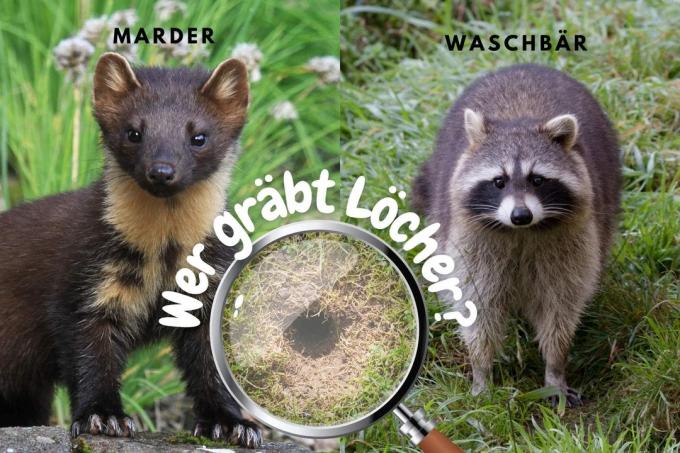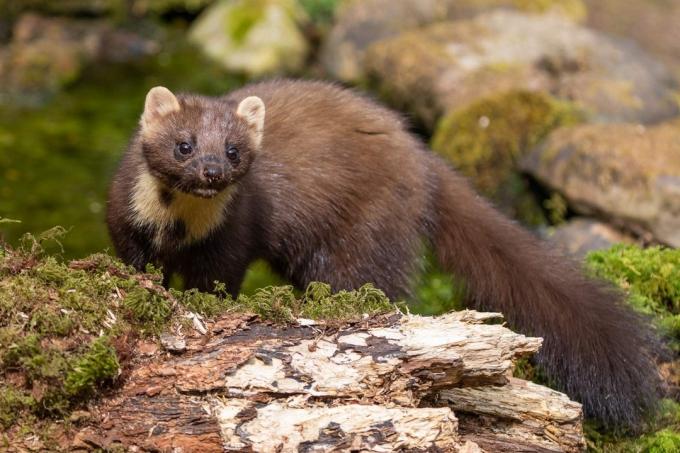
table of contents
- marten holes
- Raccoon Holes
- distinguishing features
- frequently asked Questions
By spring at the latest, martens (Mustelidae) and raccoons (Procyon lotor) are active in the gardens. But do martens and raccoons also dig holes in the garden?
In a nutshell
- Martens or raccoons usually only dig superficially
- Exception: for feeding on cages or enclosures
- Raccoons also use marten holes
- Intruders not only recognizable by holes
- behavior, faeces and noises as identifying features
marten holes
marten do not usually dig holes in the ground in the middle of the garden or in flower beds. Unlike raccoons, they are extremely shy. When digging into the ground, they could not have a full view of their surroundings. In addition, they feed on worms, etc., which are on the surface of the earth, which is why they do not make holes in them when looking for food race and have to dig beds.

Consequently, holes in gardens are usually not martens. But there is one exception:
- Floor holes on animal cages or enclosures
Anyone who owns a rabbit or chicken coop in the garden and finds a hole in the floor frame there cannot rule out a Mustelidae as the culprit. This predatory animal is drawn into the cages/enclosures because, as carnivores, it mainly attacks chickens, rabbits and hares. Eggs and offspring also often fall victim to it. Access to the stable/enclosure is gained by digging a tunnel that runs from the outside in. But even raccoons don't stop at stables/enclosures.
Raccoon Holes
Like martens, raccoons do not dig deep, typical holes in soil and turf. Holes in the ground that end in tunnels are also no indication of the presence of a raccoon. The only reason for digging this predator is better at the food reach, which is just below the surface of the earth.

That is why a raccoon always leaves traces that quickly identify it as this:
- groove-like indentations
- scratch marks
- earthworks
- only superficial excavations
Raccoon access in animal cages
In contrast to martens, a raccoon does not dig a tunnel to enter the enclosure. It is a very clever and cunning predator that can mostly get through gaps in construction and even open some locking mechanisms. The fact is: raccoons don't dig holes in the ground, even in enclosures and cages. At most, scratch marks can be seen directly behind wire mesh on the floor when they want to get eggs out of there.

Tip: If you have an enclosure for birds, chickens, rabbits or hares in the garden, you should definitely ensure that there is a secure locking option. There are usually simple sliders that raccoons can easily open if they are not specially secured with a padlock.
distinguishing features
Anyone who discovers turbulence or hole-like excavations in their garden should not only rely on the type of hole for animal identification. For example, if a marten has dug a previously undiscovered hole in the chicken coop, a raccoon can then use this to get in and become the egg thief. On the other hand, martens can also get through openings without leaving burrows or tunnels.

Therefore, in gardens, in addition to closer inspection of holes, if any, attention should always be paid also be placed on the following characteristics to recognize the differences between the martens and raccoons be able:
- main nocturnal activity in martens; Raccoons also diurnal
- great shyness in martens; Raccoons less shy of humans
- Size of marten droppings: 1 to 2 centimeters thick, 8 to 10 centimeters long; Raccoon droppings shorter and thinner
- Marten droppings: sausage-shaped with a twisted tip; Raccoons leave poop
- Smell of marten faeces: unpleasantly intense; pungent smell of raccoons, pungent in the nose
- hissing, screaming Sounds from martens: squeaking and squeaking noises coming from raccoons
- Scent markings from martens: foul odor from glandular secretion; Raccoon scent mark reminiscent of musk

Tip: While raccoons are often more familiar with humans, they can still be considered a threat to them. An approach should be avoided in any case to avoid an attack with very painful bites.
frequently asked Questions
Raccoons hibernate during the winter and only wake up occasionally to feed, especially when temperatures are very low. Contrary to numerous opinions, all marten species do not hibernate or hibernate. On the contrary, they are particularly active and always looking for places that offer them protection from the cold. This primarily includes engine compartments and attics. In the garden, however, they are rarely out and about in winter.
This is difficult, especially with the martens. They are extremely shy and responsive. As soon as they hear a sound that could mean they're getting closer, they're gone. It can be easier with the raccoon, because he doesn't run away when he's suspicious and isn't quite as shy. However, both animal species are predominantly nocturnal. Hunger and curiosity also draw raccoons out of their hiding places during the day.
Yes. Vegetables and fruit are among the foods from the vegetable patch. They especially like to eat seeds. If this falls from the plants onto the soil of the vegetable patch, raccoons also scratch through the soil surface in search of more seeds.


